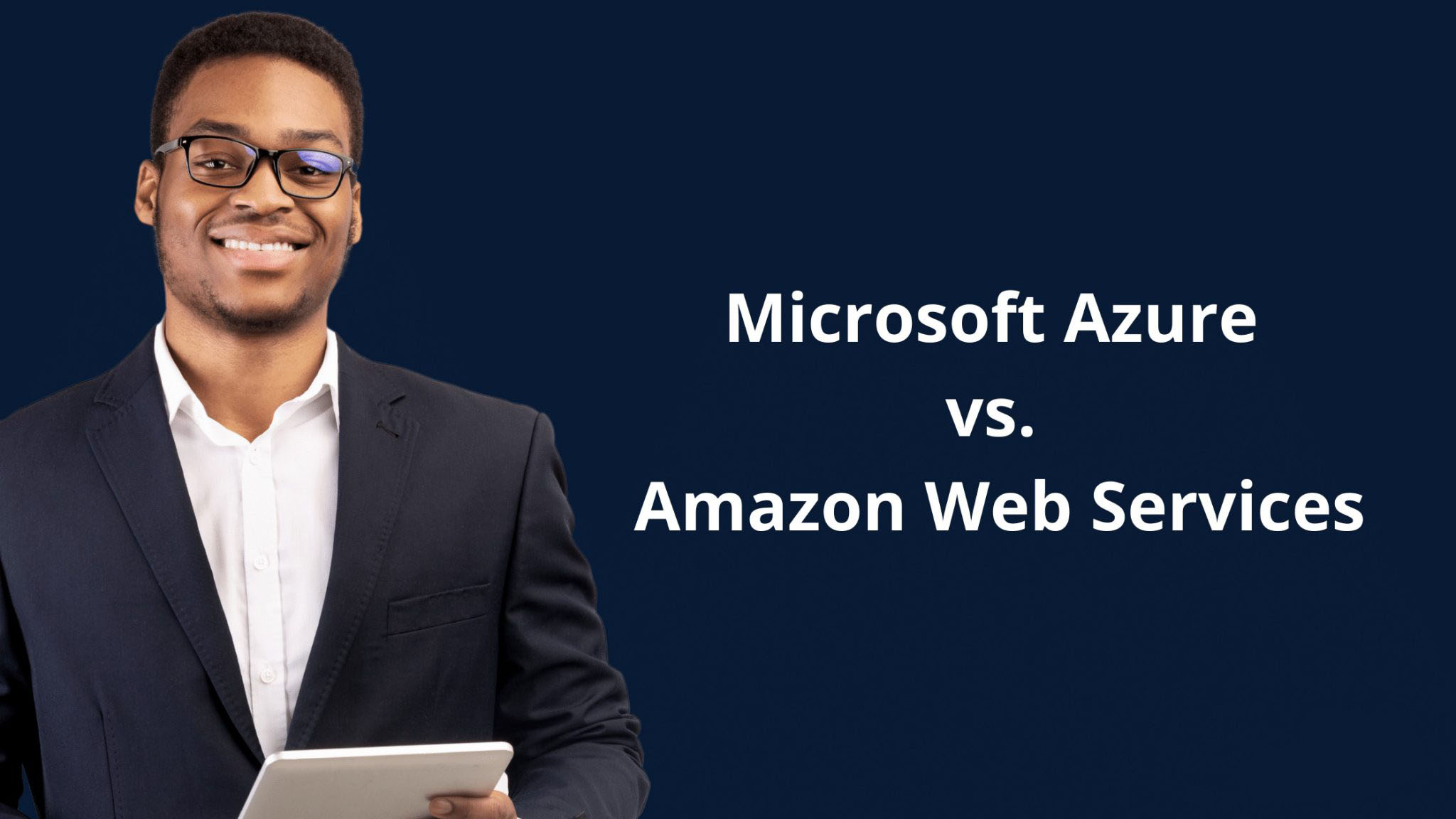Microsoft Azure vs. Amazon Web Services
Jun 09, 2023 Anthony Latham Blog 7 min read



Buyer’s Guide: Microsoft Azure vs. Amazon Web Services
You’re Living in the World of the Cloud but are You Lost in the Cloud?
The cloud is one of the biggest technological industries worldwide — approximately 80% of businesses are using public or private clouds.
However, the cloud is still an intimidating topic for many business owners, leaders, and managers. That’s because it can be extremely complicated. From the nature of the cloud to its many applications and features, you could spend weeks trying to evaluate options for your business and still be at a loss. Here is some information that can help guide you on your cloud journey.
Why Do You Need Microsoft Azure or Amazon Web Services?
Businesses are choosing to work with companies like Microsoft or Amazon for their cloud because it’s easy and cost-effective.
Key benefits include:
- Outsourced Infrastructure: You get Microsoft or Amazon to handle the hardware component of your cloud, and the expensive maintenance that comes with it.
- Extended Support: Instead of having your in-house team or outsourced IT company take care of your infrastructure, the experts from Microsoft or Amazon handle it for you.
By working with a cloud provider like Microsoft or Amazon, you get increased flexibility, scalability, and availability, without having to maintain your own infrastructure.
Azure vs. AWS: An Overview
On the surface, Azure and AWS seem fairly similar. They have a number of components and service elements in common, including self-service, security, instant provisioning, and auto-scaling. As with many things in the world of IT, it’s the details and the minor contrasts between the two that make the biggest difference for users like you.
In order to determine which option is right for you, it’s important to know what you’re looking for, and which provider is offering it. Some items of consideration:
- Computing Power: A basic consideration for evaluating one cloud option over another. The key difference between Microsoft and Amazon is the way in which they scale to deliver more computing power as needed:
- Microsoft Azure: As configured by the user, a third-party cloud service provider, or Microsoft itself, Azure creates a VM based on a selected VHD. This provides scalability (the access to additionally needed computing resources) through virtual sets. Azure VMs pair with other tools to help deploy applications on the cloud.
- AWS: Based on EC2, AWS users can:
- Configure their own VMs.
- Choose pre-configured machine images (MIs) Or customized MIs that provides users with the freedom to determine the size, power, memory capacity, and number of VMs they wish to use, based on their requirements, allowing for optimal compatibility with a range of options.
- Storage: In the cloud world, storage is a close second to computing when it comes to key considerations. How does one option organize storage and what limits does it have? In this case, Azure and AWS have fairly similar offerings:
- Microsoft Azure: Microsoft offers temporary, block and object storages, and virtual network capabilities to create isolation in the cloud. It’s important to understand the two classes of storage offered:
- Hot Storage: Hot storage is more expensive, as the assumption is that users will access and use it more often. It’s ideal for data that you will actively access and update.
- Cool Storage: Cool storage is less expensive, but users incur additional read and write costs. This is ideal for archived, long-term storage of records you may only need to access for audits or store for posterity.
- AWS: This provider’s storage is based on Machine Instances (MI), which are VMs hosted in their infrastructure. AWS offers temporary, object and block storage (separate or attached to an instance), as well as virtual private clouds to create isolated networks.
Whereas both options offer as much storage as you need (of course, at a higher and higher cost), each has a specific limit on the size of stored objects: 4.75TB for Azure, and 5TB for AWS.
- Databases: Both options are easily integrated with NoSQL and relational databases, delivering high availability and durability.
- Microsoft Azure: Offers an extensive range of database capabilities:
- SQL-based options including SQL Database, Database for MySQL and Database for PostgreSQL
- Data Warehouse service
- Cosmos DB and Table Storage for NoSQL
- Redis Cache for in-memory service
- Server Stretch Database for hybrid storage service designed specifically for businesses that use Microsoft SQL Server in their own data centers
- Additionally, Microsoft does offer an actual Backup service, as well as Site Recovery service and Archive Storage
- AWS: Offers a relational database service (RDS) that supports a range of popular database engines:
- Amazon Aurora
- MariaDB
- Microsoft SQL
- MySQL
- Oracle
- PostgreSQL
This means that, if you’re locked into one of these databases, that gives that option a clear advantage for you.
- Security: Security is a top priority especially as it relates to your IT and the cloud. Using a public cloud service, even when creating private clouds, assumes a certain degree of risk. That’s why you need to ensure that the necessary security standards are in place with your choice of cloud.
- Microsoft Azure: Designed around the principals of the Security Development Lifecycle, Microsoft has made embedding best-practice security requirements in everything they create a mandatory part of their software development process. Based on a virtual network, users can create isolated networks, in addition to subnets, private IP ranges, route tables, and network gateways. Cross-network connectivity is granted via a VPN gateway. Azure Active Directory has built-in security features including authentication tools, access control, and identity management in addition to their own top-notch network and system security. Certifications include ITAR, DISA, HIPAA, CJIS, FIPS, and more. Security is provided so that only screened persons can access the cloud.
- AWS: AWS delivers both security and flexibility, meeting the high standards of military, international finance, and other highly regulated sectors that rely on AWS. This service keeps user data secure with 230 distinct security, compliance, and governance systems. Using a virtual private cloud (VPC), AWS allows users to create isolated private networks. API gateways allow for cross-premises connectivity, and elastic load balancing during networking allows for seamless operation. Using a VPC allows users to create subnets, private IP ranges, route tables, and network gateways. Certifications include ITAR, DISA, HIPAA, CJIS, FIPS, and more. Security is provided so that only screened persons can access the cloud.
- Pricing: As far as your CFO is concerned, this is likely priority number one. Pricing depends on the type of instances required, as well as a business’s needs and usages. At the end of the day, you have to know how your cloud service is priced. To start, you should know that both options provide free introductory tiers, which allows you to try the service before committing any of your IT budget to it. Furthermore, if you’re in the process of moving from onsite infrastructure to the cloud, you’ll also benefit from a superior pricing model. Whereas Capital Expenditures (CapEx), on-premise IT solutions, are paid for upfront and see a gradual return over the following months and years, Operating Expenses (OpEx) are “pay-as-you-go”. You only pay for the cloud month by month, which vastly reduces the window between investment and return. However, once you do decide on one option or the other, you’ll find stark differences in their pay-as-you-go pricing:
- Microsoft Azure: Service is charged by the minute. You can also choose between monthly or pre-paid charges, with longer commitments allowing for greater discounts.
- AWS: Service is charged by the second, with instances purchasable:
- On-demand (pay for what you use)
- Spot (bid for extra available capacity)
- Reserved (reserve an instance for 1-3 years with upfront costs based on use)
It’s also important to note that, as an industry leader, AWS tends to be the more expensive option with its longer tenure and portfolio.
- Support: It’s important to consider how much help you’ll need, and how it may cost you. You need to factor in whether you have a cloud service provider, an outsourced IT team, or an internal IT team. You need to know whether they have certifications in or experience working with one cloud platform or the other. This will help you gauge how much support you’ll need, in line with how each provider charges for that support:
- Microsoft Azure: Users are billed a flat monthly rate. If your business is more likely to require support on a regular basis, you can easily make this monthly rate worth your while.
- AWS: Users are billed on a sliding scale tied to monthly usage. That means, if you need a lot of support, you’ll pay a lot more, and vice versa. More sophisticated and IT-mature businesses that can handle support internally will benefit from lower support costs with Amazon.
Microsoft Azure: The Pros And Cons
Advantages Of Microsoft Azure
- Integration: The key benefit of Azure is that it is designed for Microsoft users. If you’re already a Microsoft-based business, Azure seamlessly integrates into your current environment, drastically lowering the complexity, cost, and timeline of a migration. Your users will adapt to using it more quickly, as it is all in-line with the ubiquitous Microsoft experience.
- Pricing: Between its by-the-minute pricing model and flat-rate support offering, Azure is more cost-effective to use for most businesses.
Disadvantages Of Microsoft Azure
- Limitations: Azure simply can’t compete with AWS’ depth of service. It does what it does well, but it doesn’t fill quite as many distinct roles as its competitor.
- Enterprise Capability: As the younger of the two services, Azure is not as prepared to support Enterprise environments. Larger, multi-location and multi-national businesses may not get the flexibility they’re looking for from Azure right now.
Amazon Web Services: The Pros And Cons
Advantages Of Amazon Web Services
- Extensive Capabilities: Whether it’s the 175 cloud-based solutions offered, or the integration with six different popular databases engines, AWS outpaces Azure in terms of depth of service. If you’re already dependent on one of these engines, or in need of a solution AWS offers, it has a distinct advantage over its competitor.
- Enterprise-Ready: As an early player in the global cloud computing space, AWS benefits from a head start in developing enterprise capability.
Disadvantages Of Amazon Web Services
- Cost: Because of its by-the-hour pricing, and its considerable market share, AWS is priced like an industry-leader. It may not fit into the budget of small and medium-sized businesses entering the world of the cloud.
Which Is Right For You?
At the end of the day, there isn’t a clear winner in this head-to-head. One isn’t obviously better than the other. In many ways, they offer highly comparable capabilities — where they differ will come down to what your business needs.
In a nutshell, here’s a high-level summary of what each has to offer, through the lens of what your business may be looking for:
Microsoft Azure: If your business already relies on Microsoft solutions, and is looking for a cost-effective entry point into cloud computing, then Azure is almost certainly the better choice for you.
AWS: If you’re an expansive corporation, with a large budget for IT, that utilizes one of AWS’ six database engines, then AWS may be better prepared to handle your needs.
If you’re still undecided or would like help in your evaluation, reach out to our team.
Sourcepass can help guide you to the right cloud platform by evaluating your options and determining which solution best meets your needs. No matter where you are with the cloud, our team of IT specialists can provide troubleshooting assistance or strategic advice, helping you to leverage the power of these cloud technologies to their benefit. Sourcepass will help you with:
- Migration Management: If you’re not sure which solution is right for you or how to migrate all of your workstations over, we’ll walk you through the entire migration process, handling each step of the way to make sure it goes smoothly.
- Comprehensive Support: We offer onsite and remote support to help you resolve any sort of configuration and/or troubleshooting issues right away. If we’re not able to remotely resolve the issue, we’ll come onsite to help you out.
- Employee Training: A vital component of the success strategy of any software offering is the ability for a business’ employees to understand it well enough to utilize it to its fullest potential. We’re here to walk your staff through any new features or applications.
If you are interested in finding out how Sourcepass can help you get on the cloud, contact Anthony Latham, Director of Solutions Architecture at (877) 678-8080.
Subscribe To Our Newsletter
Stay in the loop and never miss out on the latest updates by subscribing to our newsletter today!











